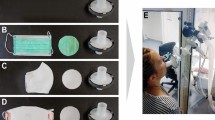Abstract
Four healthy firemen worked on the bicycle ergometer during four steps: (1) without a mask; (2) with a mean mask pressure equal to atmospheric pressure; (3) with a slight positive mean pressure of + 3.1 cm H2O inside the mask; (4) with a higher positive mean pressure of + 6.3 cm H2O inside the mask and a minimal mask pressure of + 2.2 cm H2O. Intraesophageal mean pressure increased only half as much as mask pressure. Only a slight tachycardia and a slight arterial hypotension was seen in step 4 compared to the control steps. Accordingly, a moderate increase of the preejection period (PEP) and a decrease of the left ventricular ejection time (LVET) was recorded, leading to a rise of the PEP/LVET ratio (left ventricular dysfunction). In contrast, no trace of arterial hypoxemia was seen. Opening of closed airways may explain this unexpected result.
The new positive pressure respirator used in this study seems to be suitable for rescue work in smoke and toxic gases. The following preconditions have to be remembered: (1) The mean pressure in the mask should never exceed + 6.5 cm H2O; (2) a fireman's physical performance seems to be reduced to 2000–2500 ml/min O2 uptake; (3) the upright body position may increase positive pressure-induced tachycardia and arterial hypotension.
Similar content being viewed by others
References
Chassot, J., Meyer, E., and Scherrer, M.: L'oxygénothérapie ambula toire. Schweiz. Med. Wschr.103, 1234 (1973)
Hooper, R. G., Whitcomb, M. E.: Systolic time intervals in chronic obstructive pulmonary disease. Circulation50, 1205 (1974)
Kumar, A., Falke, K. J., Geffin, B., Aldredge, C. F., Laver, M. B., Loewenstein, E., Pontoppidan, H.: Continuous positive-pressure ventilation in acute respiratory failure. New Engl. J. Med.283, 1430 (1970)
Meyer, E., Scherrer, M.: Vergleichende atemphysiologische Untersuchung dreier Atemschutzgeräte. Schweiz. Med. Wschr.104, 346 (1974)
Pride, N. B., Permutt, S., Riley, R. L., Bromberger-Barnea, B.: Determinants of maximal expiratory flow from the lungs. J. Appl. Physiol.23, 646 (1967)
Scherrer, M.: Heimbehandlung der chronischen Ateminsuffizienz. Schweiz. Med. Wschr.105, VIII (1975)
Scherrer, M., Birchler, A.: Altersabhängigkeit des alveolo-arteriellen O2-Partialdruckgradienten bei Schwerarbeit in Normoxie, Hyperoxie und Hypoxie. Med. Thorac.24, 99 (1967)
Weissler, A. M.: Noninvasive Cardiology. New York: Grune and Stratton (1974)
Weissler, A. M., Harris, W. S., Schoenfeld, C. D.: Systolic time intervals in heart failure in man. Circulation37, 149 (1968)
Author information
Authors and Affiliations
Additional information
This study was supported by grants from the Schweizerischer Nationalfonds zur Förderung der wissenschaftlichen Forschung
Rights and permissions
About this article
Cite this article
Meyer, E., Gurtner, H.P. & Scherrer, M. Physiologic appraisal of a new rescue respirator with positive pressure. Pneumonologie 153, 61–72 (1975). https://doi.org/10.1007/BF02096335
Received:
Issue Date:
DOI: https://doi.org/10.1007/BF02096335




